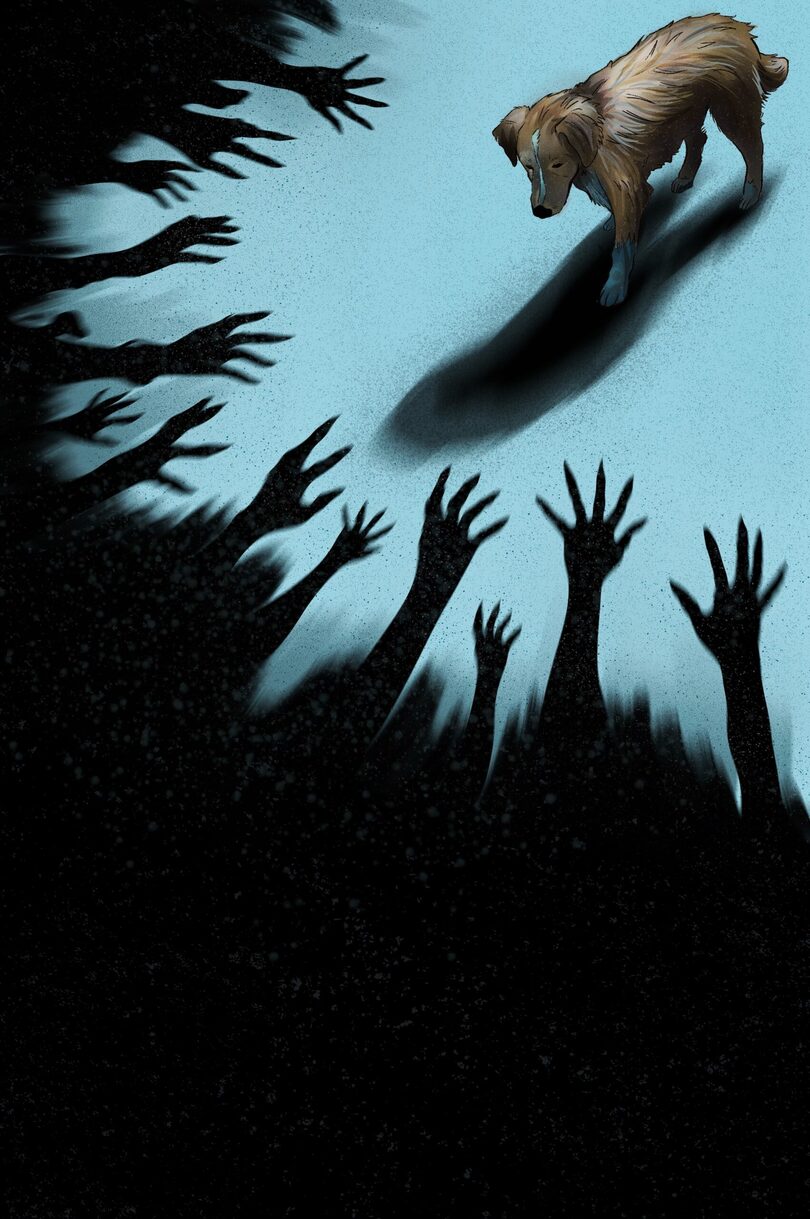‘Good Boy’ conjures fresh horror through obscured narrative, inventive visuals

“Good Boy” literally tells its story from the perspective of a dog — most of the shots come from a low perspective, obscuring human faces. The camera operators often weren’t behind their cameras to avoid distracting the star of the show, the dog. Emma Soto | Contributing Illustrator
Get the latest Syracuse news delivered right to your inbox.
Subscribe to our newsletter here.
“Good Boy” is proof that dogs should be eligible for the Oscars.
Ben Leonberg delivers a standout thriller movie about man’s best friend — and his worst enemy — in his directorial debut. The film follows retriever Indy (played by the director’s dog of the same name) as he helps his owner, Todd (Shane Jensen), fight a chronic illness that might just kill them both.
In a media landscape of action movies and slasher flicks, this film stands out. Its singular premise, style and acting left me understanding the actions of every character, even if I was sometimes frustrated by them.
This film won’t hand you answers. It doesn’t explain certain plot points, such as the exact nature of Todd’s illness. In a world of hyperliteral Marvel Entertainment heroes and tired tropes, “Good Boy”’s obscure approach to exposition feels oddly refreshing. It allows the film’s monster to be a metaphor for a number of topics, including grief, family expectations and addiction.
After moving to his dead grandfather’s isolated home, Todd cuts ties with his concerned sister, leaving his dog to ward off a physical manifestation of his illness and family trauma. The only problem is that Indy can’t tell what’s happening, leading Todd to push him away when they need to be together the most.
In a sense, Leonberg and his team have created a contemporary eldritch horror film. Indy’s surrounded by death, both in the form of his owner’s creeping sickness and the taxidermied trophies of the cabin’s previous occupant.
The pair’s new home, a sprawling cabin in the woods, feels strange and hostile, and you can’t help but feel bad for Indy as he’s forced to battle his owner’s chronic illness. To a dog, this is inexplicable, especially when it’s given a corporeal form. Indy seems to have little hope of survival, or even understanding.
Indy’s performance is impressive. He doesn’t speak or open doors, and his acting isn’t enhanced by computer-generated imagery. You’re seeing an actor in his element, giving the role everything he’s got. Fittingly, the film gives us a dog’s-eye view of the world. The cinematography (led by Wade Grebnoel) takes Indy’s short stature into account; nearly every shot is a low angle.
Environments we should be familiar with, such as the cabin, feel foreign, lending a sense of tension to the whole affair that would sorely be missed otherwise. Some sequences completely blur the line between Indy’s perception and reality, arguing that a dog’s view of the past and present is totally different than our own.
Viewers never see an unobscured human face in the entire 73-minute runtime. It’s just us, fractured reflections of people, Indy and some intentionally jarring high-angle shots at key moments. Leonberg and co-writer Alex Cannon don’t waste your time, delivering a perfectly pitched tone and well-executed thrills.
Above all else, “Good Boy” is an anxious film. The score, acting and shot selection all combine to create a foreboding atmosphere that occasionally crosses the line into terror. What jumpscares there are feel earned, not cheap or tacky.
Every shot is used to its fullest potential, from beginning to end; no corners have been cut here. The fact that all of this was done with an animal in the lead role (one who, according to the post-credits scene, had no special training) is doubly impressive.
This film’s initial shooting took three years. Leonberg’s commitment to using his real dog meant the small crew had to shoot in one-to-three hour chunks and break the filming of one scene into four or five days.
The director and his wife were on dog-wrangling duty, strategically positioned just out of shot to pull Indy’s attention at the right moment. The camera operators were almost never behind the cameras themselves, instead setting up shots before to avoid distracting the star.
This filming setup led to some compromises elsewhere. Some of the dialogue sounds like it was recorded in a studio rather than on set, and some cuts seem confusing or unmotivated. Certain special effects also seem cheap, likely a casualty of the movie’s limited budget.
Even so, the fact that something like this is not only watchable, but enjoyable, is a technical miracle and a testament to editor Curtis Roberts’ craft.
A question that will likely be on the minds of many prospective viewers: does the dog die? Will he get “Old Yeller’d”, or perhaps “Turner & Hooch’d”? I feel that knowing beforehand whether the dog dies or not would take the basic point of tension out of the film. If you’re persuaded by this argument, skip the next sentence. No, Indy doesn’t die.
Leonberg takes what could be a novelty premise and elevates it to a truly original horror film that is more than the sum of its parts. His crew’s commitment to his idea and the inventiveness of its execution speak volumes to his skill, and I can only hope to see another of his films on the big screen in the future. If you see “Good Boy” in theaters, make sure to stick around for the exclusive behind-the-scenes reel of Indy in action.






